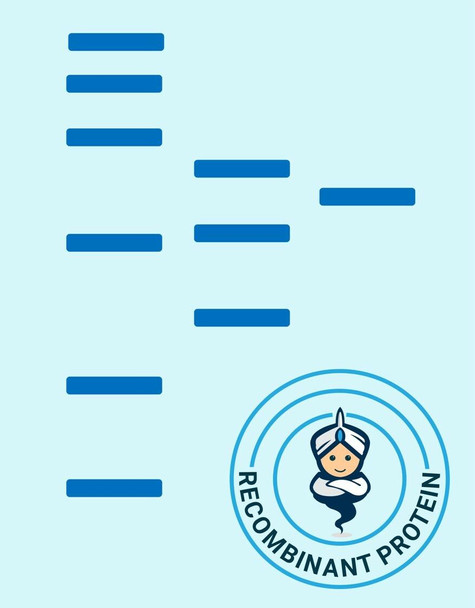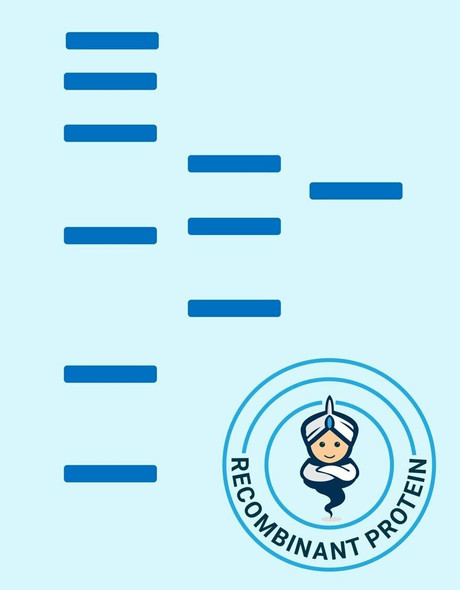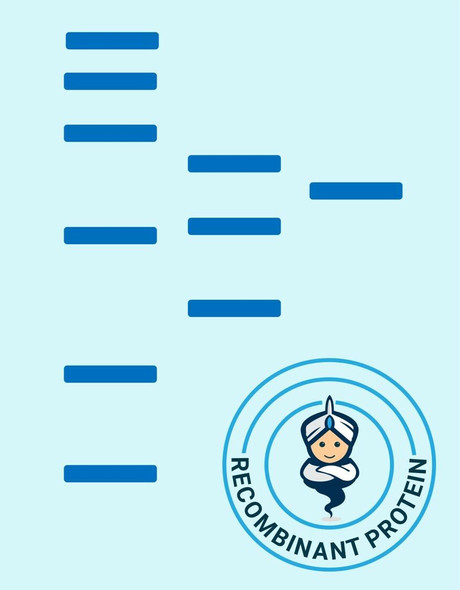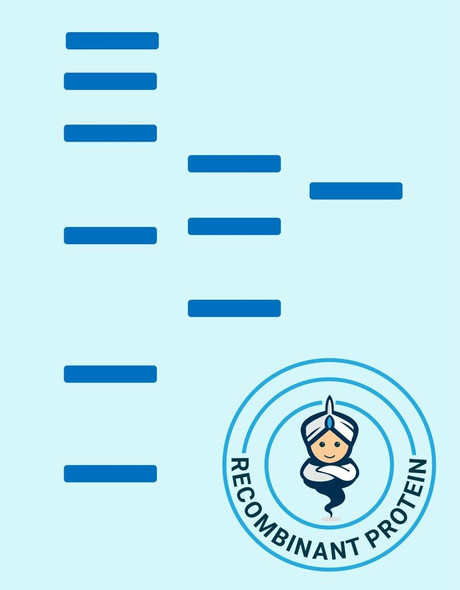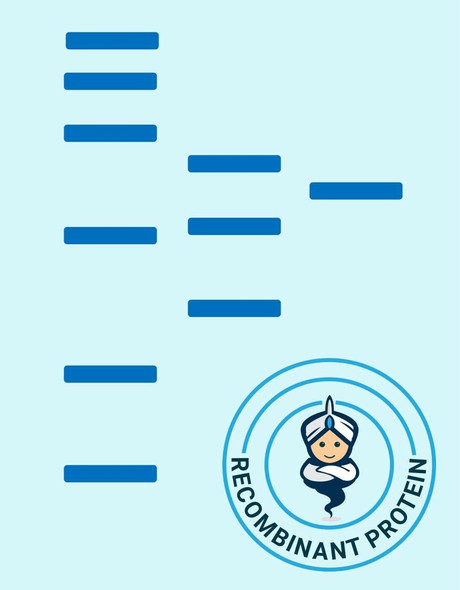PRKAR1A Recombinant Protein (RPPB2628)
- SKU:
- RPPB2628
- Product type:
- Recombinant Protein
- Size:
- 3ug
- Target:
- PRKAR1A
- Synonyms:
- cAMP-dependent protein kinase type I-alpha regulatory subunit
- Tissue-specific extinguisher 1
- TSE1
- CAR
- Source:
- Escherichia Coli
- Uniprot:
- P10644
Description
| Product Name: | PRKAR1A Recombinant Protein |
| Product Code: | RPPB2628 |
| Size: | 3µg |
| Target: | PRKAR1A |
| Synonyms: | cAMP-dependent protein kinase type I-alpha regulatory subunit, Tissue-specific extinguisher 1, TSE1, CAR, CNC, CNC1, PKR1, PPNAD1, PRKAR1, PRKAR1A, MGC17251, DKFZp779L0468. |
| Source: | Escherichia Coli |
| Formulation: | PKA regulatory subunit I a is supplied in 50% glycerol. |
| Stability: | Store at 4°C if entire vial will be used within 2-4 weeks. Store, frozen at -20°C for longer periods of time. Avoid multiple freeze-thaw cycles. |
| Purity: | Greater than 90% as determined by SDS-PAGE. |
cAMP-dependent PKA is an ubiquitous serine/theonine protein kinase present in a variety of tissues (e.g. brain, skeletal muscle, heart). The intracellular cAMP level regulates cellular responses by altering the interaction between the catatytic C and regulatory R subunits of PKA. The inactive tetrameric PKA holoenzyme R2C2 is activated when cAMP binds to R2, which dissociates the tetramer to R2 cAMP 4 and two active catalytic subunits. Free Catalytic subunits of PKA can phosphorylate a wide variety of intracellular target proteins. In response to hormone- induced high cAMP levels, PKA phosphorylates glycogen synthetase (inhibition of the enzyme activity) and phosphorylase kinase to block glycogen synthesis. Different isoforms of catalytic and regulatory subunits suggest specific functions. The recombinant PKA regulatory subunit I a is a dimeric 90kDa protein.
| UniProt Protein Function: | PKAR1A: a regulatory subunit of cAMP-regulated protein kinase. The inactive form of the enzyme is composed of two regulatory chains and two catalytic chains. Activation by cAMP produces two active catalytic monomers and a regulatory dimer that binds four cAMP molecules. Four types of regulatory chains are found: I-alpha, I-beta, II-alpha, and II-beta. Their expression varies among tissues and is in some cases constitutive and in others inducible. Interacts with RFC2: the complex may be involved in cell survival. Defects in PRKAR1A are the cause of Carney complex type 1 (CNC1). CNC is a multiple neoplasia syndrome characterized by spotty skin pigmentation, cardiac and other myxomas, endocrine tumors, and psammomatous melanotic schwannomas. |
| UniProt Protein Details: | Protein type:Protein kinase, regulatory subunit Chromosomal Location of Human Ortholog: 17q24.2 Cellular Component: protein complex; membrane; plasma membrane; neuromuscular junction; cytosol; AMP-activated protein kinase complex; cAMP-dependent protein kinase complex Molecular Function:protein binding; ubiquitin protein ligase binding; cAMP-dependent protein kinase inhibitor activity; cAMP-dependent protein kinase regulator activity; cAMP binding Biological Process: epidermal growth factor receptor signaling pathway; fibroblast growth factor receptor signaling pathway; nerve growth factor receptor signaling pathway; water transport; activation of protein kinase A; female meiosis; cardiac muscle cell proliferation; sarcomere organization; signal transduction; regulation of transcription from RNA polymerase II promoter; mesoderm formation; phospholipase C activation; negative regulation of meiosis; energy reserve metabolic process; innate immune response; renal water homeostasis; blood coagulation; regulation of insulin secretion; transmembrane transport Disease: Myxoma, Intracardiac; Carney Complex, Type 1; Thyroid Carcinoma, Papillary; Acrodysostosis 1 With Or Without Hormone Resistance; Pigmented Nodular Adrenocortical Disease, Primary, 1 |
| NCBI Summary: | cAMP is a signaling molecule important for a variety of cellular functions. cAMP exerts its effects by activating the cAMP-dependent protein kinase, which transduces the signal through phosphorylation of different target proteins. The inactive kinase holoenzyme is a tetramer composed of two regulatory and two catalytic subunits. cAMP causes the dissociation of the inactive holoenzyme into a dimer of regulatory subunits bound to four cAMP and two free monomeric catalytic subunits. Four different regulatory subunits and three catalytic subunits have been identified in humans. This gene encodes one of the regulatory subunits. This protein was found to be a tissue-specific extinguisher that down-regulates the expression of seven liver genes in hepatoma x fibroblast hybrids. Mutations in this gene cause Carney complex (CNC). This gene can fuse to the RET protooncogene by gene rearrangement and form the thyroid tumor-specific chimeric oncogene known as PTC2. A nonconventional nuclear localization sequence (NLS) has been found for this protein which suggests a role in DNA replication via the protein serving as a nuclear transport protein for the second subunit of the Replication Factor C (RFC40). Several alternatively spliced transcript variants encoding two different isoforms have been observed. [provided by RefSeq, Jan 2013] |
| UniProt Code: | P10644 |
| NCBI GenInfo Identifier: | 125193 |
| NCBI Gene ID: | 5573 |
| NCBI Accession: | P10644.1 |
| UniProt Secondary Accession: | P10644,Q567S7, K7ER48, |
| UniProt Related Accession: | P10644 |
| Molecular Weight: | 42,982 Da |
| NCBI Full Name: | cAMP-dependent protein kinase type I-alpha regulatory subunit |
| NCBI Synonym Full Names: | protein kinase, cAMP-dependent, regulatory, type I, alpha |
| NCBI Official Symbol: | PRKAR1A |
| NCBI Official Synonym Symbols: | CAR; CNC; CNC1; PKR1; TSE1; ADOHR; PPNAD1; PRKAR1; ACRDYS1 |
| NCBI Protein Information: | cAMP-dependent protein kinase type I-alpha regulatory subunit; Carney complex type 1; tissue-specific extinguisher 1; protein kinase A type 1a regulatory subunit; cAMP-dependent protein kinase regulatory subunit RIalpha; cAMP-dependent protein kinase type I-alpha regulatory chain |
| UniProt Protein Name: | cAMP-dependent protein kinase type I-alpha regulatory subunit |
| UniProt Synonym Protein Names: | Tissue-specific extinguisher 1 |
| Protein Family: | CD83 antigen |
| UniProt Gene Name: | PRKAR1A |
| UniProt Entry Name: | KAP0_HUMAN |

